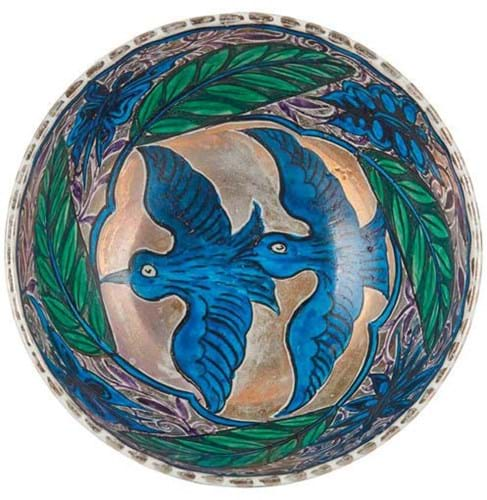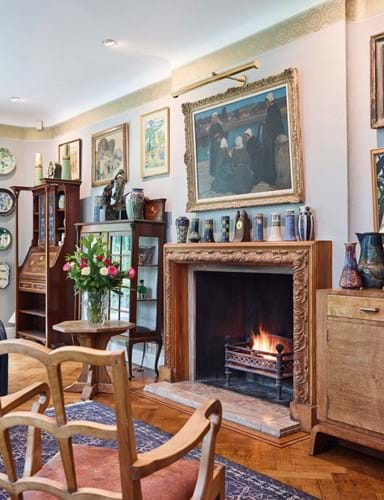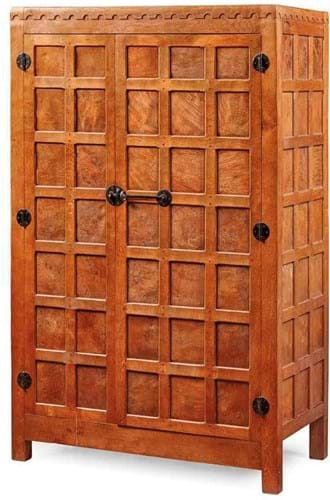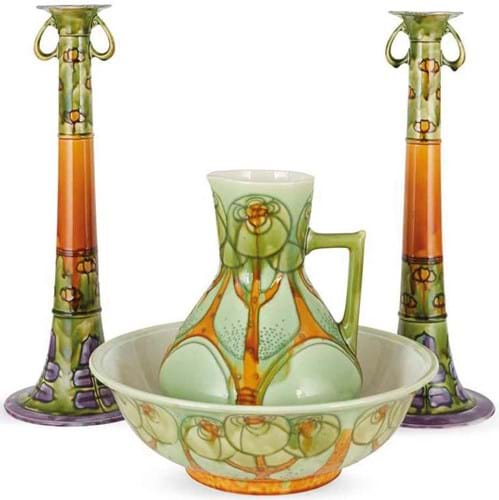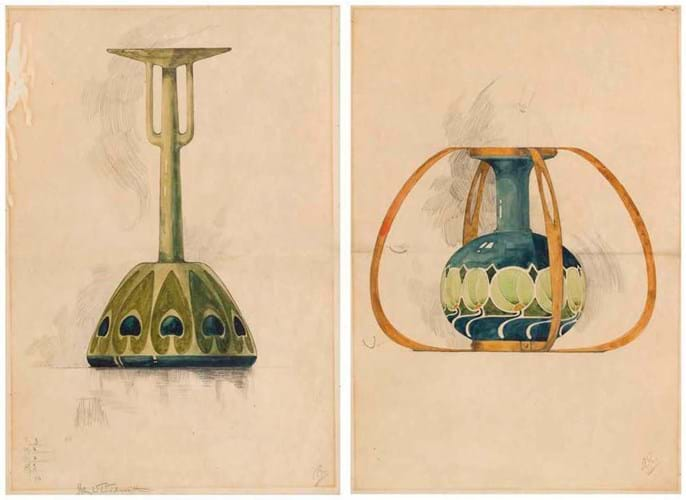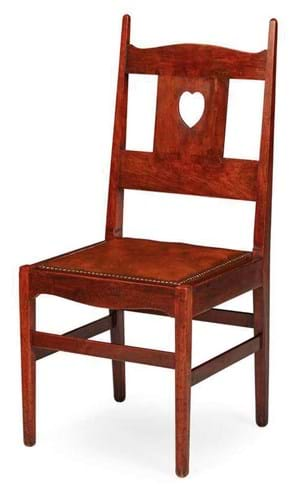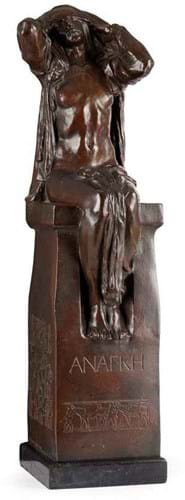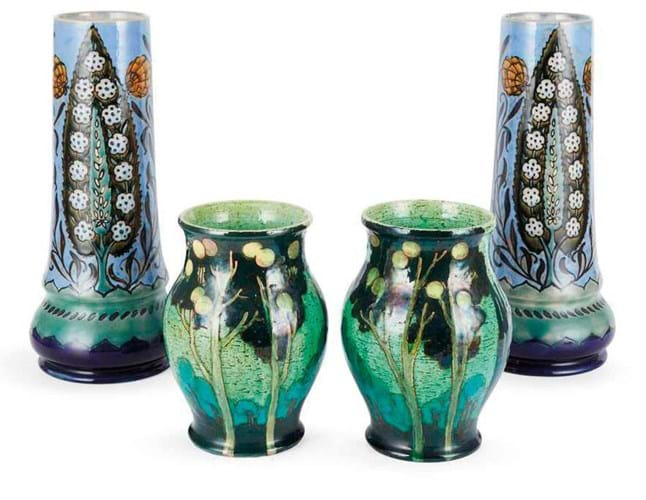
Two pairs of Royal Doulton Barbotine vases designed by Margaret E Thompson c.1920, the larger pair 13in (32cm) high, £800 at Lyon & Turnbull.
Chris Hancock studied architecture and design in London during the late Sixties and would later have his own practice.
From a very young age he had been an enthusiastic collector and the instinct never left him.
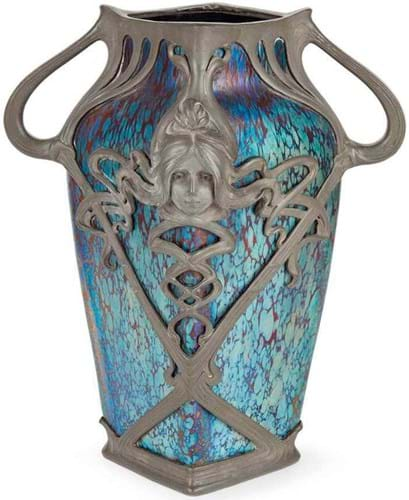
Loetz twin handled iridescent glass vase c.1900 with pewter mounts, possibly by Boudon & Klur, Paris, 11in (27cm) high, £4800 at Lyon & Turnbull.
A lifelong passion for ‘dec arts’ – the avant garde furniture, ceramics and metalwork created by the progressive design and craft movements of the late 19th and 20th centuries – was later augmented by an interest in modern and contemporary prints.
In the catalogue for his collection, sold by Lyon & Turnbull (26% buyer’s premium) in Edinburgh on January 25, his wife Carol noted: “Living with Chris was akin to living with a museum curator with his own private museum. There were always new pieces of art works coming into the house and fighting for space on a wall or in a cabinet.
“His ‘museum’ was also a family home to three lively boys and several pets over the years. We lived alongside this fascinating collection as it grew over 50 years.”
Great finesse
As the accompanying photography suggested, the collection, arranged across a St Albans home with great finesse and attention to detail, was more than the sum of its parts.
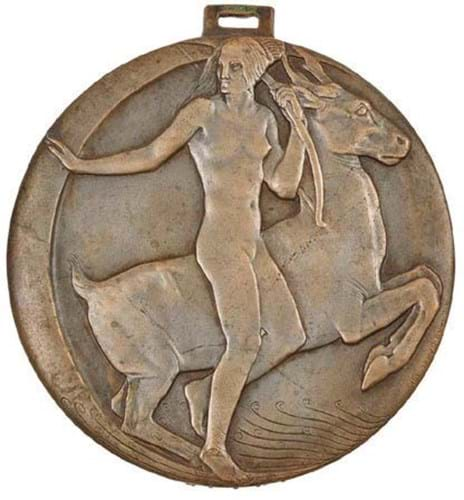
Patinated bronze plaque of Diana, signed and dated 1917 by Richard Garbe, 12½in (32cm) diameter, £1300 at Lyon & Turnbull.
“For a collection of this type, assembled at a time when it was fashionable to focus carefully on one or two subject areas, this was unusually eclectic,” said head of sale Philip Smith. “The unifying theme was the collector and his interested eye.”
There were multiple collections within the collection. Hancock’s myriad areas of specialisation included Doulton stonewares and Minton Secessionist ceramics, furniture by Thompson of Kilburn, silver by William Hutton & Sons, sculptural wares by Gilbert Bayes and etchings by Graham Sutherland.
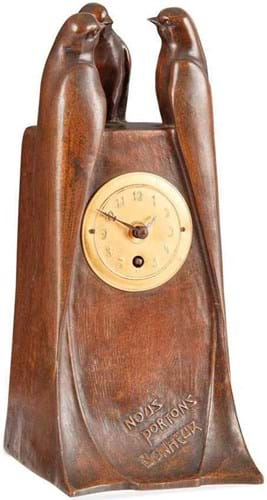
Nous Portons Bonheur patinated bronze mantel clock designed by Anton Puchegger, c.1910, 9in (23cm) high, £3000 at Lyon & Turnbull.
Keen to preserve this sense of a whole, the urge to split the elements across multiple sales was resisted.
“Picking through it, moving the pictures to two sales and the objects to others, would have missed something of the effect,” said Smith. “We wanted people to know they were buying from one man’s collection and that’s what we got last month.”
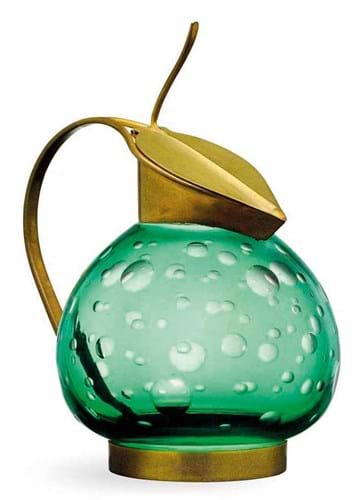
Gilt metal and cased green glass decanter designed by Koloman Moser for Bakalowits Sohne, Vienna, c.1899, 9in (23cm) high, £6000 at Lyon & Turnbull.
Accompanied by estimates that did not push the envelope, 98% of the 347 lots were sold for a hammer total of £552,130 that was close to double the low estimate.
Secessionist sensation
Among the most eagerly contested subsets were pieces from Minton’s most successful Art Nouveau range.
Secessionist Ware was the product of two men: Léon-Victor Solon (1872-1953), the son of famed Minton designer Louis Marc Solon, and his Macclesfield-born assistant John Wadsworth (1879-1955) who joined the factory in 1901.
They collaborated on the project that took its name from a progressive Austrian art movement and much of its visual inspiration from the Glasgow School. The range, identified by its bold colours and distinctive slip-trailed technique, had its own special Minton’s factory mark that was designed by Solon and Wadsworth.
Hancock had a fine selection of more than 50 of these wares – and some important related archival material he had acquired when Phillips Knowle conducted a sale of the Wadsworth estate in 1992.
Two of the most popular lots were a pair of 21in (52cm) tall Secessionist Ware candlesticks together with a jug and bow wash set and two original ink and watercolour designs by Wadsworth, each 21 x 15in (55 x 38cm). Guided at around £500 each, these sold at £2400 and £2800 respectively.
Harris design
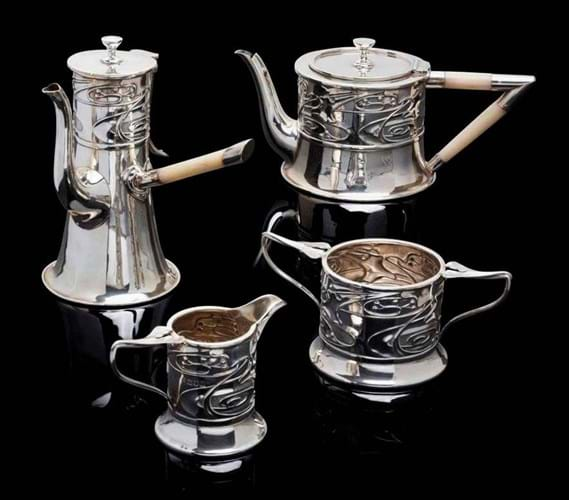
Silver and mother-of-pearl tea and coffee set designed by Kate Harris for William Hutton & Sons London, 1906-11, £6000 at Lyon & Turnbull.
Rather like John Wadsworth, Kate Harris is not as well-known today as some of her contemporaries, but she was one of the most important designers for the London-based firm, William Hutton & Sons.
Working in what can be termed the commercial Arts & Crafts style, from 1899 to c.1905, she produced a series of designs for domestic silver that were featured and admired in The Studio and other magazines at the time.
Included in this sale were a dozen pieces to designs by Harris. As was the standard commercial practice of the day, they carry only the Hutton name and not that of the designer.
They included an example of the 1902 silver plated copper and brass inkstand that was adopted as that year as a prize by the Art Union of London.
The Union’s annual report that year wrote of her design: ‘The charming and original inkstand, designed for the Society by Miss Katie J Harris will be especially noticed… Miss Harris’ future career will be watched with interest.’
Eighteen were made as prizes – this one took £1500.
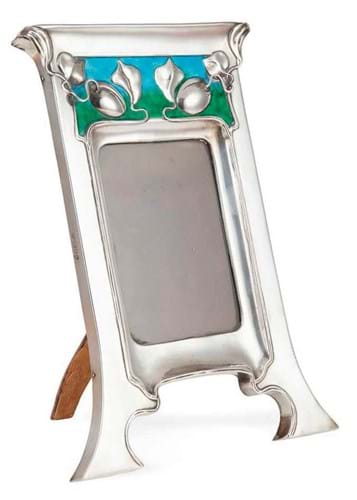
Silver and enamel photo frame by William Hutton & Sons, London 1903, 12in (30cm), £2600 at Lyon & Turnbull.
A large 12in (30cm) silver and enamel photo frame from 1903 sold at £2600 (estimate £400-600). With various dates from 1906-11, a four-piece silver and mother-of-pearl tea and coffee set with ‘whiplash’ foliate designs made £6000 (estimate £1200-1800).
Voysey auction buy
Working in London and living in Hertfordshire, Hancock had been well placed for shopping in galleries and auction houses.
Two mahogany side chairs by Charles Voysey, bought at Dreweatt Neate in Newbury in 1994, took £5500 each. The model with a heart-shaped cut-out in the back splat is familiar, with most thought to have been produced by the London cabinetmaker FC Nielsen which also made other furniture designed by Voysey.
A tell-tale construction detail is the large dovetails joining the splat to the frame.
However, the choice of timber is less so. Voysey’s preferred material for furniture was unstained and unpolished oak. He did occasionally specify other materials when the other furniture in the house was of a differing material. He reiterated this to Arthur Simpson of Kendal in 1909 stating that: “You must have oak everywhere or nowhere. I will not be a party to the mixture.”
Nine pieces by or attributed to British sculptor Gilbert Bayes (1872-1953) ranged from a Cupid and the Lovers silvered bronze buckle c.1900 (£400) to elements of the St Pancras Housing Association project made by Royal Doulton in the 1930s. One of the washing line post finials, modelled as a Roman galleon, had some condition issues but took £1200.
Leading the Bayes’ offering at £28,000 (estimate £6000-8000) was the emotive First World War work of a semi-nude grieving female titled Anatkh or Destiny.
Bayes rose to prominence in tandem with the burgeoning demand for monumental sculpture in the wake of the First World War, his workshop at the forefront of the war memorial movement.
Destiny was shown at the Royal Academy in 1916, and subsequently used as the centrepiece for the Ramsgate War Memorial. This bronze statuette of the model standing 23in (59cm) high on its slate base was produced later in 1918.


